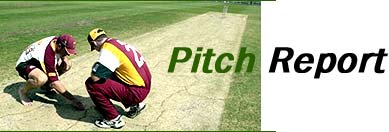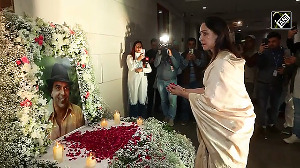
Tamil Nadu Cricket Association
Date of inspection: 21 September 2002
Present: N Srinivasan (President)
C Vijaya Raghavan (Hon Secretary
Kasi Vishwanathan (Assistant Secretary)
Mr Shankarrao (Assistant Secretary)
P.R. Vishwanathan (Grounds committee - Curator)
Muthukrishnan (Chairman grounds committee)
Dr D N Seshagara (Grounds committee)
Dr Natarajan (Management Committee)
V A Parthasarthy (Senior VP)
Prabhakar Raol (Vice President)
K Parhasardathy (Grounds in charge)
Mr Anammalai (Assistatn Groundsman)
Kasturi Rangan (BCCI - Chairman of Ground and Pitches)
Bill Walmsley (NZ Sports Turf Institute)
Present condition of ground
The cricket square has only been partially reconstructed due to the rainy season. A section of the block 50ft (15 m) wide was dug up and replaced with a layer of new pitch soul.
The main block has been constructed from a mixture of predominantly dark brown/black soil and local red soil. The black soil is a lake bed sediment from the suburbs of Chennai. The main block appears to be mostly black soil with some red soil incorporated. There is more black soil near the surface. Two strips at the side of the main block have been constructed from a mixture of a white Kaolin porcelain clay and red soil.
The ground is establishing quickly following reconstruction. The area inside the 35m circle has been sown with hybrid Bermuda, while the rest of the outfield is Cynodon dactylon.
The excessive slope on the outfield has been corrected and it now looks to have a uniform slope to the boundary. Thin areas towards the edge of the ground have yet to fully cover.
The pop-up irrigation system is used to maintain a green outfield year-round. A novel groundwater recharge system utilities rainwater from the roof for irrigation.
Prospects for sporting pitches
The practice cricket match did not achieve good bounce height. Core samples taken from the pitch indicated that the density of the soil was still low down to 75 mm depth.
Pre-season rolling needs to be repeated until adequate base density is achieved.
It is good to see the NPK fertilizers used to promote growth in the block and outfield. In places turf is growing too thickly on the block, needing frequent mowing and use of the detaching reel. Take care to apply just enough fertilizer to attain coverage and no more! Too much thatchy growth on the block is undesirable.
I am reluctant to predict the performance of the soil mixture used, but I feel it is unnecessarily complicated by blending red soil with black soil. I prefer to see a block comprised solely to black soil. Effort should be made to sample and laboratory test black soils from a wide geographical range, to discover the range of variability of the soil, and identify superior types for cricket pitches.
Our limited experience in New Zealand with cricket clays comprising of high quantities of Kaolin clay mineral have not been encouraging due to their low strength and difficulties decompacting the non-swelling clay.
I await with interest to hear of the performance of the experimental strips.
Limitations on producing a quality outfield
Parts of the outfield are still thin and establishing. I recommend that an effort is made to establish grass cover on every square metre of the outfield, including areas at the vehicle entrance to the ground. The coring machine could be used to good effect here and for 5 m around the outside of the cricket square to relive compaction. Simply core the area up to three times per year, then break the cores up on the surface and drag them into core holes using a steel meash drag mat.
Take care not to apply too much fertilizer to the outfield. Too much fertilizer will only grow excessive leaf growth and quickly build up thatch. Judge the need for fertilizer on turf density, not colour alone.
The area of hybrid Bermuda inside the 35-yard circle will require vigorous scarifying several times per year. The use of a mechanical scarifier would be appropriate. Regular verti-cutting using the `dethatching' reel on the mower is also a good idea.
I recommend that the whole of the outfield is mowed by reel mowers and not rotary mowers from now on. Save use of the rotary mower for times when grass grows long after a period of rain.
The outfield has been top dressed with a mixture of sand; coir peat: red soil 50:30:20.
The high proportion of sand added to the red soil, which already has about 30% soil content, will be significantly improving the porosity of the surface layers. I am not convinced it is necessary to add sand to the soil mixture. I prefer to see only soil and compost used.
Equipment limitation
Save use of the Toro 1000 for mowing the cricket square and possibly mowing inside the 35 yard circle prior to imported matches.
At least three other walk behind reel mowers are required for the outfield
The Grounds Pro 2000 is unlikely to be able to be adjusted to mow closely enough for a cricket outfield. This is a belt driven `surrounds trimmer' type mower with a minimum height adjustment of about 9 mm.
It is not able to mow to the 4-6m height required for the outfield. A `golf greens mower' type triplex mower is needed for this purpose.
The BCCI roller (dark green RATNA) has a steering roller shorter than the main roller. I suggest not using the roller if possible. If it does need to be used it could be modified along the lines suggested in Appendix 14.
The coring machine will be useful for decompacting any areas in the outfield and will probably be useful on cricket pitches as well, but its effectiveness should not be over estimated.
The corner is most effective at decompacting soil when the out-going coring tyne lifts and loosens the soil. In reality it does not loosen soil much. It can be helpful when loose soil is worked into core holes and they are filled with loose soil.
Core holes could be a significant problem on cricket pitches if they remain open to the surface during preparation, increasing the surface area for moisture loss.
I suggest limiting use of the coring machine on pitches to renovation time at the end of the playing season only, when soil will be applied immediately afterwards to fill up the core holes. Hand forking can be most effective at loosening compacted soil in cricket pitches.
Organisation limitations to producing a high quality cricket venue
There appears to be plenty of energy and enthusiasm to produce the best possible playing conditions for cricket by the TNCA.
The TNCA is truly fortunate to have the services of Mr K Parthasardathy, Grounds in Charge of 30n years experience.






